
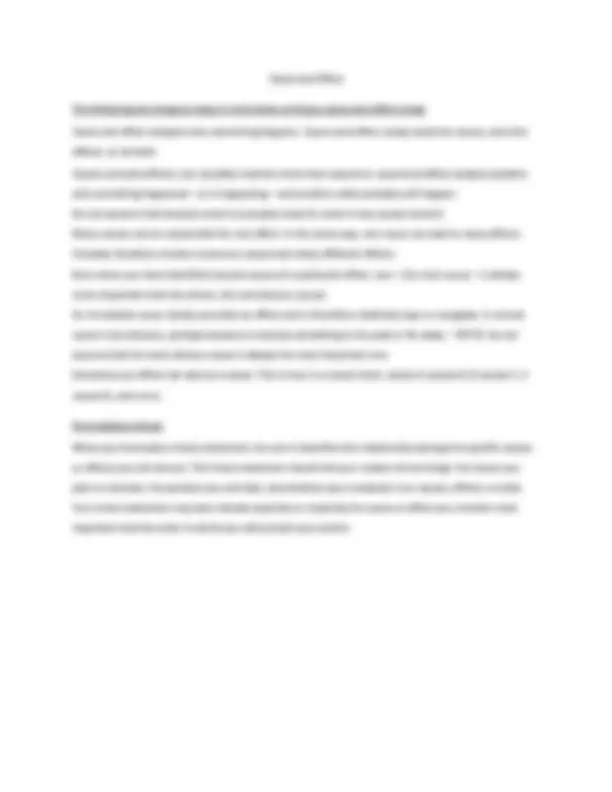
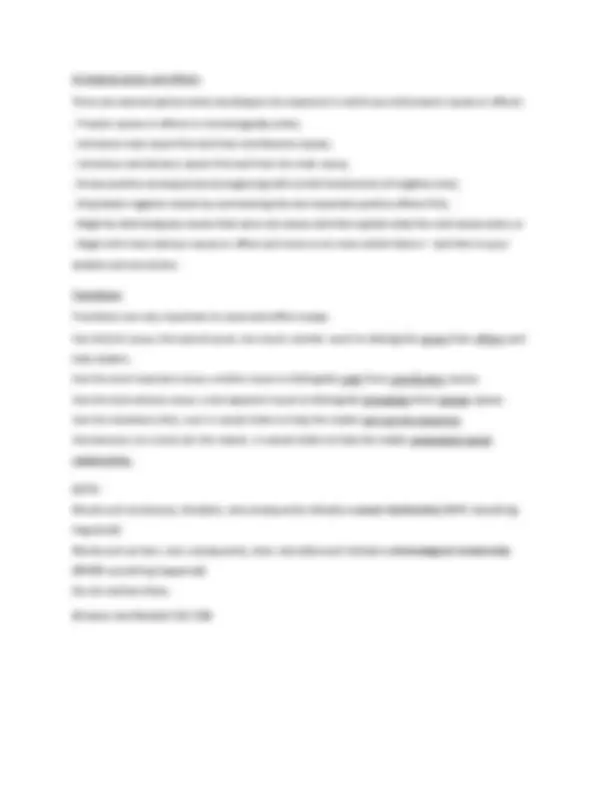
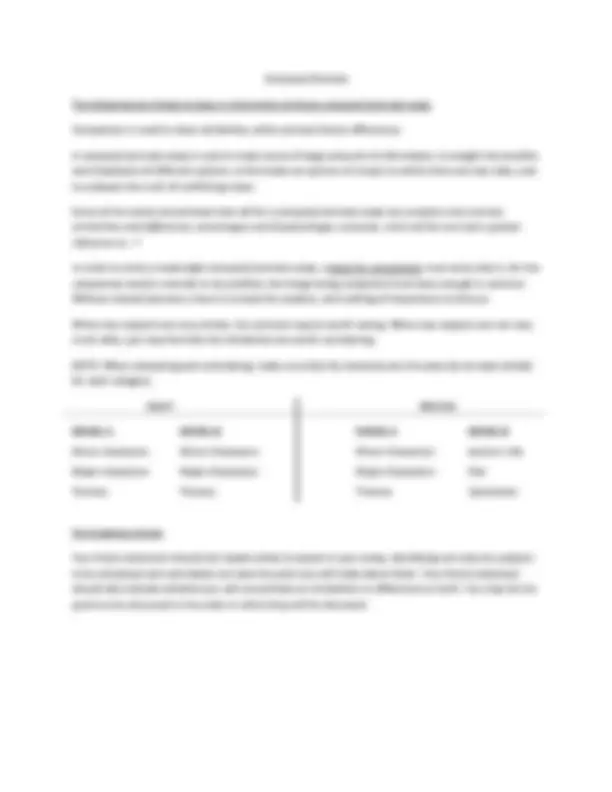
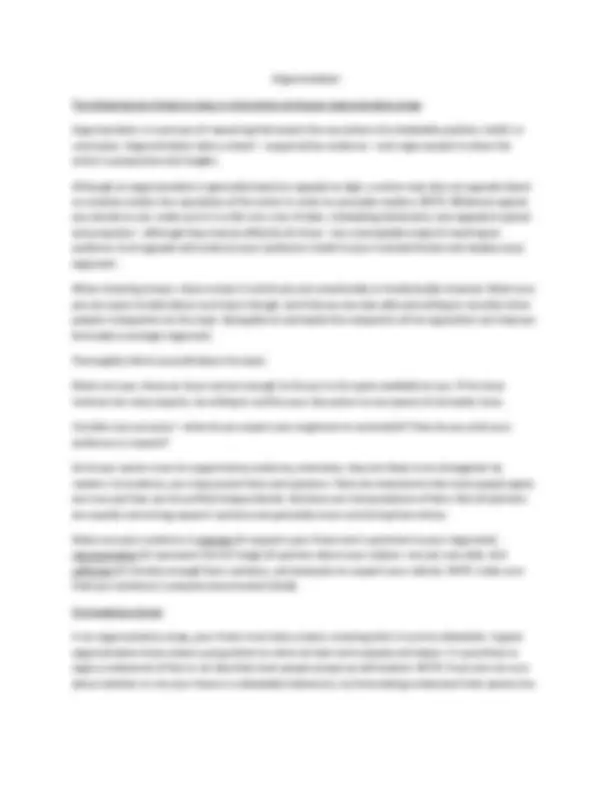
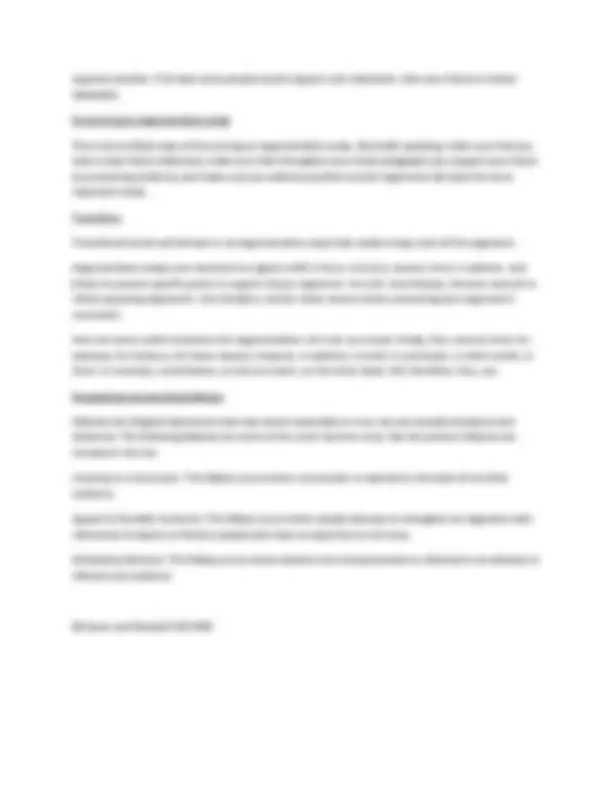


Study with the several resources on Docsity

Earn points by helping other students or get them with a premium plan


Prepare for your exams
Study with the several resources on Docsity

Earn points to download
Earn points by helping other students or get them with a premium plan
Community
Ask the community for help and clear up your study doubts
Discover the best universities in your country according to Docsity users
Free resources
Download our free guides on studying techniques, anxiety management strategies, and thesis advice from Docsity tutors
A comprehensive guide for students on how to write different types of essays, including cause-and-effect, compare/contrast, exemplification, and argumentation essays. It covers the basics of each essay type, formulating a thesis statement, arranging causes and effects or subjects, using transitions, and providing examples. It also discusses the importance of evidence and avoiding fallacies in argumentative essays.
What you will learn
Typology: Exams
1 / 9

This page cannot be seen from the preview
Don't miss anything!






Body Paragraph One
Body Paragraph Two
Body Paragraph Three
Topic Sentence
Topic Sentence
Topic Sentence
Go from the general to the specific.
Start out broad.
Use something that will catch the reader’s attention.
Go from the specific to the general. End broad.
End with a general statement, suggestion, or other thing that will make the reader continue to think about your paper.
This is the last sentence of the intro. It should state what the paper will discuss.
This is the first sentence of the intro. It should restate your thesis.
Topic Sentences introduce the evidence that will be presented in each body paragraph
Each one of the body paragraphs should support the thesis by presenting evidence for it.
Support
Arranging causes and effects
There are several options when deciding on the sequence in which you will present causes or effects:
analysis and conclusion.
Transitions
Transitions are very important to cause-and-effect essays
Use the first cause, the second cause; one result, another result to distinguish causes from effects and
help readers.
Use the most important cause, another cause to distinguish main from contributory causes.
Use the most obvious cause, a less apparent cause to distinguish immediate from remote causes.
Use the transitions then, next in causal chains to help the reader sort out the sequence.
Use because, as a result, for this reason¸ in causal chains to help the reader understand causal
relationships.
NOTE:
Words such as because, therefore, and consequently indicate a causal relationship (WHY something
happened).
Words such as then, next, subsequently, later, and afterward indicate a chronological relationship
(WHEN something happened).
Do not confuse these.
(Kirszner and Mandell 321-330)
Compare/Contrast
The following are things to keep in mind when writing a compare/contrast essay
Comparison is used to show similarities, while contrast shows differences.
A compare/contrast essay is used to make sense of large amounts of information, to weight the benefits and drawbacks of different options, to formulate an opinion of a topic to which there are two sides, and to evaluate the truth of conflicting views.
Some of the words and phrases that call for a compare/contrast essay are compare and contrast, similarities and differences, advantages and disadvantages, evaluate, which of the two had a greater influence on…?
In order to write a meaningful compare/contrast essay, a basis for comparison must exist; that is, for the comparison and/or contrast to be justified, the things being compared must have enough in common. Without shared elements, there is no basis for analysis, and nothing of importance to discuss.
When two subjects are very similar, the contrast may be worth noting. When two subjects are not very much alike, you may find that the similarities are worth considering.
NOTE: When comparing and contrasting, make sure that the elements are the same (or at least similar) for each category.
RIGHT WRONG
NOVEL A NOVEL B NOVEL A NOVEL B
Minor characters Minor Characters Minor Characters Author’s life
Major characters Major Characters Major Characters Plot
Themes Themes Themes Symbolism
Formulating a thesis
Your thesis statement should tell readers what to expect in your essay, identifying not only the subjects to be compared and contrasted, but also the point you will make about them. Your thesis statement should also indicate whether you will concentrate on similarities or differences or both. You may list the points to be discussed in the order in which they will be discussed.
Exemplification
The following are things to keep in mind when writing an exemplification essay
Exemplification uses one or more particular cases, or examples, to illustrate or explain a general point or an abstract concept.
Sweeping generalizations and vague statements are not nearly as effective as specific observations, anecdotes, details, and opinions.
Use examples to explain, clarify, add interest, and persuade. How many examples is enough to support your thesis will depend on your thesis and your purpose.
Choose a sufficient range of examples.
Formulating a thesis
The thesis statement of an exemplification essay makes a point that the rest of the essay will support with examples. This statement usually identifies your topic as well as the main point you want to make about it. NOTE: before formulating a thesis, think of the examples you will present in support for it; that way, you will be able to test your ideas and their validity as well as understand the opposing viewpoints.
Structuring an argumentative essay
Exemplification essays usually begin with an introduction that includes the thesis statement, which is supported by examples in the body of the essay. Each body paragraph may develop a separate example, present a point illustrated by several brief examples, or explore one aspect of a single extended example that is developed throughout the essay. The conclusion reinforces the essay’s main idea.
When deciding how to structure the body of an essay, keep in mind that there are various ways in which to do it. Examples may be grouped according to content (each paragraph dedicated to a group of examples with the same content). Examples may also be developed fully in separate paragraphs.
Examples may be arranged chronologically, in order of increasing complexity (beginning with the simplest and moving to the most difficult or complex), or in order of importance (beginning with those that are less significant and moving to those that are most significant or persuasive).
Transitions
Be sure to use transitional words and phrases to introduce your examples. Without them, readers will have difficulty seeing the connection between an example and the general statement it is illustrating. Some helpful transitions for an exemplification essay are another, for instance, for example, in fact, namely, specifically, that is, and thus.
(Kirszner and Mandell 211-218)
Argumentation
The following are things to keep in mind when writing an argumentative essay
Argumentation is a process of reasoning that asserts the soundness of a debatable position, belief, or conclusion. Argumentation takes a stand – supported by evidence – and urges people to share the writer’s perspective and insights.
Although an argumentation is generally based on appeals to logic, a writer may also use appeals based on emotion and/or the reputation of the writer in order to persuade readers. NOTE: Whatever appeal you decide to use, make sure it is a fair one. Lies, threats, misleading statements, and appeals to greed and prejudice – although they may be effective at times – are unacceptable ways of reaching an audience. Such appeals will undercut your audience’s belief in your trustworthiness and weaken your argument.
When choosing a topic, chose a topic in which you are emotionally or intellectually invested. Make sure you are open minded about such topic though, and that you are also able and willing to consider other people’s viewpoints on the topic. Being able to anticipate the viewpoints of the opposition can help you formulate a stronger argument.
Thoroughly inform yourself about the topic.
Make sure you chose an issue narrow enough to discuss in the space available to you. If the issue involves too many aspects, be willing to confine your discussion to one aspect of a broader issue.
Consider your purpose – what do you expect your argument to accomplish? How do you wish your audience to respond?
All of your points must be supported by evidence; otherwise, they are likely to be disregarder by readers. As evidence, you may present facts and opinions. Facts are statements that most people agree are true and that can be verified independently. Opinions are interpretations of facts. Not all opinions are equally convincing; experts’ opinions are generally more convincing than others.
Make sure your evidence is relevant (it supports your thesis and is pertinent to your argument), representative (it represents the full range of opinions about your subject, not just one side), and sufficient (it includes enough facts, opinions, and examples to support your claims). NOTE: make sure that your evidence is properly documented (cited).
Formulating a thesis
In an argumentative essay, your thesis must take a stand, meaning that it must be debatable. A good argumentative thesis states a proposition to which at least some people will object. It is pointless to argue a statement of fact or an idea that most people accept as self-evident. NOTE: if you are not sure about whether or not your thesis is a debatable statement, try formulating a statement that asserts the